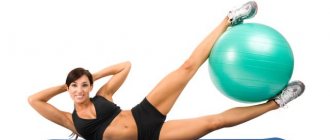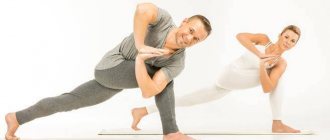Everyone knows about the benefits of warming up before any physical activity, but many people neglect the cool-down, considering it an unnecessary step. Some people don’t even know what a cool-down after a workout is and for what purpose it is needed. In the article we will talk about this training element in more detail and give examples of cool-down exercises for home and gym.
What is a hitch?
First of all, let’s find out what a hitch is. Essentially, this is the opposite concept of warming up. Cooling down after cardio or strength training involves a transitional physical activity necessary for a smooth transition of the body from active physical work to a state of rest.
During a cool-down, the pace of movements slows down, physical activity decreases, exercises become simpler, and muscles stretch. In this way, a smooth adaptation of all body systems to the changed living conditions occurs.
What is it for?
First of all, a cool-down is necessary to normalize the functioning of the heart and blood vessels. During intense exercise, the heart rate increases and the delivery of oxygenated blood to the muscles increases. And in organs that at this moment need less replenishment (kidneys, liver, digestive tract), blood flow decreases.
During the cool-down exercises after a standard workout, the level of stress hormones in the blood gradually decreases, which leads to a slower heart rate and lower blood pressure. The vessels in the muscles narrow, and in other organs they gradually expand. This prevents the development of oxygen starvation.
Cooling down also has a beneficial effect on the respiratory system. When the intensity of physical work decreases, the need for oxygen decreases, the respiratory muscles begin to work slowly, which prevents hyperventilation.
Note!
The main symptoms of hyperventilation include dizziness, a feeling of confusion in the head, darkening of the eyes, and trembling in the limbs. If this condition appears after training, then you need to sit down, calm your breathing, and perform several breathing exercises.
Another reason not to forget about the cool-down is the need to quickly normalize muscle condition. During physical exercise, muscle fibers become shorter and thicker. This makes normal, everyday physical activity difficult. During the cool-down, the muscles gradually lengthen, returning to their original state, and lactic acid, the main source of post-workout muscle pain, is quickly removed from them.
Pro Tips
The main goal of a cool-down is to gradually remove the load from the body. It is associated not only with the process of decreasing heart rate and the ability to “catch your breath.” During a cool-down, the remaining waste products in the muscles are also removed, and the concentration of lactic acid decreases noticeably.
It is important to understand that a cool-down cannot be a cure for muscle pain over the next few days. Unpleasant sensations in the muscles are a natural reaction of the body to the regular progress of loads. However, if you cool down regularly, it will reduce the intensity of pain and improve your overall condition.
It is important to do a cool-down after all workouts, since a sudden cessation of exercise negatively affects the cardiovascular system and the general condition of the body. In addition, at the end of strength training, all muscles are maximally warmed up and ready for stretching.
If you've been planning to do the splits or improve your flexibility, cool-down time is the best time for such purposes. At this stage, the risk of sprains and other injuries is minimized, and the joints are prepared for the appropriate load.
When a person is just starting to work out in the gym or planning training at home, warm-up and cool-down play almost the same role for him as the main training for strength or endurance. In practice, I notice that most athletes remember to warm up their muscles and only 1/4 practice the full completion of the training.
Regardless of whether you are involved in professional sports or want to pump up for the summer, I recommend doing special cool-down exercises for 10-15 minutes. This amount of time is enough to fully stretch contracted muscles, improve blood circulation and restore normal breathing rhythm.
All cool down goals
Cooling down after classes has the following goals:
- Prevent hyperventilation;
- Smoothly bring blood flow to normal levels;
- Reduce muscle pain after exercise;
- Normalize body temperature;
- Accelerate the removal of toxins from the body;
- Reduce rest time;
- Reduce the severity of muscle fatigue;
- Resume normal functioning of the brain, digestive tract, and genitourinary system more quickly;
- Stabilize hormonal levels.
Peculiarities!
Of course, in a healthy person, the listed indicators will gradually return to normal in any case. However, with some chronic diseases, this process can be greatly slowed down without a hitch.
Why you need to warm up and cool down
Warm-up and cool-down are like brushing your teeth, everyone knows that it is necessary, important and useful, but many people neglect them. Zozhnik understands the consequences of skipping a warm-up or cool-down from a scientific point of view.
Norwegian sports doctors conducted a large-scale study in which 1,840 handball players participated. They divided the subjects into two groups: one group did a special warm-up before exercise, and the other did not.
After 8 months, they calculated the statistics and found that the players who warmed up before training showed 2 times fewer sports injuries than players who (for scientific purposes) did not warm up at all.
In general, warming up, according to the results of a number of studies and the opinion of experts, has a positive effect on all systems of the body (including the psyche), preparing it for stress.
The effect of warming up on the body and psyche
Here's what happens to the body during a warm-up: - Cardiovascular system: during a warm-up, the heart rate increases and more blood begins to circulate throughout the body. This way the muscles are better supplied with oxygen and nutrients. - Blood pressure: Blood pressure increases. Blood begins to flow faster through the vessels and thereby better supplies the muscles with nutrients. - Breathing: breathing becomes more frequent, thus increasing pulmonary ventilation and meeting the growing need for oxygen. — Nervous system: neuromuscular communication improves, thereby reducing the need for energy, the central nervous system gets tired more slowly, and the reaction speed increases. - Body temperature: during a good warm-up, body temperature rises to 38.5 - 39 degrees Celsius. Under such conditions, physiological reactions occur most efficiently. – Joints and ligaments: the body produces more joint fluid, thereby increasing the volume of articular cartilage. In this way, the pressure exerted on the articular cartilage can be more easily tolerated. Ligaments and tendons become more elastic due to increased temperature. - Muscles: muscles fill with blood, become stronger and less susceptible to damage. - Mental: Warm-up increases concentration and perception. Increased concentration helps to cope with sudden critical situations during training or competition (for example, some kind of obstacle). An optimal warm-up also increases motivation for upcoming physical activity, reduces stiffness and reduces nervousness.
General warm-up rules
As physical education specialist Heinz-Dieter Recktenwald from the University of Münster (Germany) notes, there are general rules for organizing a warm-up that must be taken into account: - Intensity: during the warm-up, body temperature should increase gradually so as not to tire the student. The intensity also depends on the time of day, weather conditions, age and training experience of the practitioner. — Duration: between 10 and 15 minutes. — Interval: the interval between warm-up and actual training should not be more than 5 minutes. Despite the fact that the body temperature remains elevated for a long time, such a very important effect as increased blood filling of the muscles rapidly decreases after a couple of minutes.
— Time of day: The time of day at which the workout and, accordingly, the warm-up is carried out is also of great importance: if you work out in the morning, the warm-up should last longer than in the evening, since the body needs time to wake up. Stretching is not a warm-up and reduces results. As part of the warm-up, you should not perform static stretching (that is, when the trainee holds the muscle under tension for a long time, stretching it).
A study conducted by the Department of Physiology at St. Stephen's University in Texas found that static stretching before a leg workout reduced subjects' squat performance in the amount of weight athletes could handle for one repetition by 8.4%. Thus, we can conclude that static stretching before exercise impairs the athletic performance of trainees, so it should not be included in the warm-up program.
Static stretching is useful as part of a cool-down, also for preventing injury, and stretching after a workout will not have a negative impact on your results.
Another thing is dynamic stretching, which is performed in the pumping style. Ideal exercises for this stretching are lunges, bodyweight squats, and burpees. This kind of stretching is ideal as part of a warm-up and helps improve muscle strength and flexibility, which was confirmed in a study by the University of North Carolina.
Cool down - transition to a calm state
Thanks to the cool-down, a faster recovery of body functions exhausted by training is achieved. The training process is a test for the body, after which it needs recovery. Recovery is one of the most important phases in gaining muscle mass. The better and faster the exerciser rests, the more intensely he can train and thus, for example, quickly build muscle mass or other trained skills.
The cool-down has the following goals: - Reducing muscle tension. — Regulation of the cardiovascular system (pulse, pressure, body temperature, etc.). — Restoration of the central nervous system. — Accelerated removal of metabolic end products (for example, lactic acid) from the body.
However, the current belief that cooling down helps avoid long-term muscle soreness is erroneous. A study conducted at the University of Sydney on 25 athletes found that cooling down immediately after exercise had no effect on long-term muscle soreness.
The cool-down should not last longer than 5-10 minutes. The pulse during the cool-down should not exceed 120 beats per minute. It can be done on an exercise bike, treadmill or elliptical trainer. It is also recommended to stretch the stressed muscles.
For self-massage after a workout, using a foam roller, which has become widespread in foreign fitness rooms, is also perfect. For a cool-down, a bathhouse, sauna, massage are also indicated - however, these procedures only complement the cool-down and cannot be its main part.
conclusions
Warming up before exercise and cooling down afterward are essential if you want to prevent injury and improve your athletic performance. Warm-up prepares the entire body for the upcoming physical activity. The cool-down, in turn, allows the body to recover and move from an excited state to a calm one. Static stretching (stretching) is performed only in the cool-down phase.
How to do a cool down correctly
When doing a cool-down, follow the basic rules:
- Start it immediately after finishing your workout, without any intermediate rest.
- During the cool-down, focus on the muscles that worked the most intensely.
- During unloading exercises, slight discomfort in the muscles is possible without pronounced pain.
- It is advisable to alternate tasks for statics and dynamics.
- Avoid sudden, jerky movements when performing exercises.
- Start stretching with large muscle groups (shoulder girdle, back, buttocks, thighs), gradually moving to smaller ones (forearms, hands, legs, feet).
- It is best to complete the cool-down with breathing exercises.
- After training, you need to drink water and have a snack within 1.5 hours. Food should include proteins and complex carbohydrates. Mineral water without gas at room temperature is best for drinking.
General recommendations for cool-down
Cool-down exercises, especially stretching, should be performed immediately after the main stage of training, while the muscles are warmed up and ready to work. Then the cool down will be most effective. You also need to monitor your breathing and allow it to recover before proceeding to the final stage of the workout.
We invite you to familiarize yourself with the Diet for weight gain: diet for girls, menu for men
The cool-down has several principles, if followed, the maximum benefit from the exercises will be achieved.
- All movements during the cool-down should be smooth, jerking and springy movements should be avoided. If you experience mild pain, you need to stay in this position for a couple of seconds.
- You cannot stretch by force; stretching should be gradual. This will allow the muscles to relax a little.
- You definitely need to breathe deeply and deeply.
- The back should remain straight when bending. All bends must be done to the maximum position, when the back does not bend.
- You can use auxiliary equipment, such as bands and blocks, to create additional support, elevation, or additional load.
- Under no circumstances is paired stretching allowed. This increases the risk of spraining ligaments and damaging joints.
- Stretching exercises can be done in front of a mirror. This way you can immediately see and correct all errors and shortcomings.
The Greenportal.pro team advises its readers not to forget about the cool-down after training. This way you will not only get the maximum benefit, but also reduce the risk of injury.
Sets of exercises for cool-down
The average cool-down duration is 10 minutes, but it all depends on the severity of the workout and the initial level of physical fitness. A set of exercises is chosen based on the type of sports training and the main purpose of the cool-down, but be sure to include elements of cardio and stretching. During stretching exercises, you need to stay in each position for 5-10 seconds.
Exercises to cool down at the end of a workout
- First of all, after training, you need cardio exercises, including running, walking, jumping, exercise on a stepper, elliptical, and exercise bike. The basic rule is to start at a fast pace and gradually slow down so that the heart can easily adapt to the new conditions.
- Then they move on to stretching. It should be light, without pain. The main task is not to do the splits, but to relax tense muscles.
- Breathing exercises are ideal to complete your cool-down. You need to practice abdominal breathing techniques so that when your chest is motionless, as you inhale, your stomach inflates, and as you exhale, it retracts.
In addition to exercise, water procedures, light massage or self-massage, which normalizes blood circulation in the skeletal muscles, help to cool down after intense sports.
Cool down in the gym
After working out in the gym, you should cool down for at least 10 minutes. Repeat dynamic elements 5-10 times.
- Run on the treadmill at a gentle deceleration.
- Punch the bag for a couple of minutes at low intensity.
- Ride the exercise bike at a leisurely pace.
- Hang on the horizontal bar for 30 seconds.
- Bring your hands together behind your back at the level of your buttocks. Slowly raise your arms up, stretching your shoulder girdle.
- Place your right hand behind the back of your head. With your left palm, press on your right elbow, stretching the muscles. Change hands.
- Standing on one leg, bend the other at the knee, pressing your foot to the gluteal region, hold it in this position with your hands. Change legs.
- Lie on your back, bring your feet toward your buttocks, and bring the soles of your feet together. Spread your knees to the sides, trying to place them on the floor.
- In the same starting position, tilt your bent legs simultaneously to the right and then to the left, while turning your shoulder girdle in the opposite direction.
Cool down at home
After practicing at home, the cool-down usually lasts 5-10 minutes. Suitable exercises:
- Running in place with a gradual slowdown and transition to steps.
- Jumping rope with low amplitude and speed.
- Jumping without a rope with clapping. To do this, you need to jump, at this moment raise your arms up to the sides, and spread your legs to the sides. During landing, the legs are placed wide and the palms clap above the head. At the next jump, the legs are connected together, and the arms are lowered along the body.
- Sit on the floor. Place your right foot closer to your body, your left leg remains extended. Bend over, reaching your left foot with your right hand, and lightly press with your left hand on the inner surface of your bent right leg, trying to bring it closer to the floor. Repeat with opposite limbs.
- Lie on the floor, pull your right leg towards your stomach, holding it with your left hand, with your right arm extended to the side. Try to press your shoulders firmly against the horizontal surface.
- Roll over onto your stomach with your arms extended forward. Raise your shoulder girdle as high as possible above the horizontal surface. Legs lie freely on the floor.
- Get on your knees. Place one hand slightly behind your back, pull the other forward. Slightly tilt your body forward, trying to pull your shoulders toward the floor. Then change hands.
- Lunge forward alternately with your right and left legs, stretching your calf muscles.
- In a standing position, spread your arms wide to the sides, bringing your shoulder blades together.
HOW SHOULD YOU WARM UP?
Warm-up consists of several parts:
- Cardio
- Joint gymnastics
- Stretching
- Technical warm-up
CARDIO
For a cardio warm-up, 3-6 minutes is enough for you.
Running or fast walking on a treadmill, exercise bike, ellipse, jumping rope. This pre-workout warm-up stage is intended to generally prepare the whole body for intense work with basic exercises; remember, they are performed immediately after the warm-up. The blood accelerates, the pulse quickens, you can safely move on to the next stage of the warm-up before training.
A small life hack: you can skip this step if you get to the gym at a fast pace
JOINT GYMNASTICS
Joint gymnastics is based on the principle: “we twist everything that spins.”
It is imperative to rotate your hands, elbows, head, twist your body, rotate your lower back, stretch your hip joints, develop your knees and ankles.
By the way, joint gymnastics of the shoulder joint is described very well by Dr. Bubnovsky in the book “Headaches or why a person needs shoulders.” I advise everyone to read it, especially those who suffer from constant migraines.
You can make it a rule to do hyperextension before each workout: this will help protect the most vulnerable part of the spine during training - the lower back.
Main muscles involved: lumbar spine, additionally loaded: hips and buttocks
Since almost all strength exercises require stabilization and a trained lower back, it is the lumbar region that beginners should pay attention to
There is no need to wave your arms/legs like a maddened mill - we do everything thoughtfully, efficiently, without sudden movements, slowly, gradually increasing the pace and intensity of the warm-up.
STRETCHING
The stretch should be of the intensity that you can withstand; do not try to do the splits or touch the floor with your nose. 3-5 minutes of SMOOTH stretching is enough.
Stretching
We remember physical education lessons: stretch our arms, back, chest, legs. Below in the article is a set of stretching exercises.
TECHNICAL WARM-UP
You perform this last and very important step immediately before the basic exercises.
When performing warm-up sets, be sure to do classic squats without weight and at least 10 squats with an empty bar - so that the muscles remember the mechanics of the movement. If the working weight is already significant, then we perform warm-up approaches in the range of 30/50/80% of it. This warm-up will protect you from injury and properly warm up your muscles.
Under no circumstances DO WE START WITH THE WORKING WEIGHT!
The same goes for other basic exercises: deadlifts and bench presses. Let the muscles remember the technique first, and then load it.
In addition to the fact that this type of warm-up will help warm up the muscle, it will also increase blood flow in the muscle being trained, which will have a positive effect on its training.
You should be HOT and sweaty after your warm-up, so don't slack off.
Is it possible to skip this step or not?
Not everyone considers a cool-down to be a necessary element of training. Some reduce its duration as much as possible, while others refuse to carry it out altogether. This, of course, will not lead to critical consequences, but it can create some problems:
- After a strenuous workout, muscles will hurt longer and more intensely;
- You will need more time to rest;
- The risk of colds will increase with temperature changes. For example, if you go out into the cold air warmed up after a workout, the chance of catching a viral infection is higher than after a cool-down;
- If insufficient blood flow in the digestive tract and other organs, formed during a period of intense muscular work, persists for a long time, this will result in disruption of its function - inflammatory diseases, slower peristalsis, esophageal reflux;
- The functioning of the cardiovascular system may be disrupted. In young healthy people, most likely, there will be no problems, but with pathologies such as heart failure, arrhythmia, coronary heart disease, an abrupt cessation of training will cause a deterioration in well-being;
- There is also a risk of a rapid drop in blood pressure, which can lead to dizziness, blurred vision, and even short-term loss of consciousness.
As a rule, experienced athletes prefer to do a cool-down after training, because they have experienced all the disadvantages of abruptly stopping exercise. Intense physical work in itself is stressful for the body, and a rapid transition to a resting state can aggravate this stress. A gentle attitude towards your own body will help you achieve better results and make training a more enjoyable pastime.
What happens if you don't cool down after a workout?
Not cooling down can lead to a significant number of negative consequences. Many athletes and amateurs skip cool-downs, thinking it's a waste of time, and end up with serious health problems that could have been avoided.
Among the negative consequences that can result from neglecting a cool-down are:
- Weakened immunity and impaired thermoregulation. Cooling down helps stabilize body temperature, and if you go outside after exercise in cool weather, there is a chance of getting sick or getting hypothermia.
- Stagnation of blood, which leads to poor circulation not only in the muscles, but also in other systems and organs.
- Slow muscle recovery, the appearance of tension.
- Excessive stress on the heart and blood vessels.
- Waste products are cleared from the muscles more slowly than after a cool-down, resulting in slower and less effective recovery from strength training.
A cool-down should be carried out in any case, regardless of the severity of the load, experience and frequency of training. Cool-down exercises can be standard and not change as the load increases at the main stage of training.









